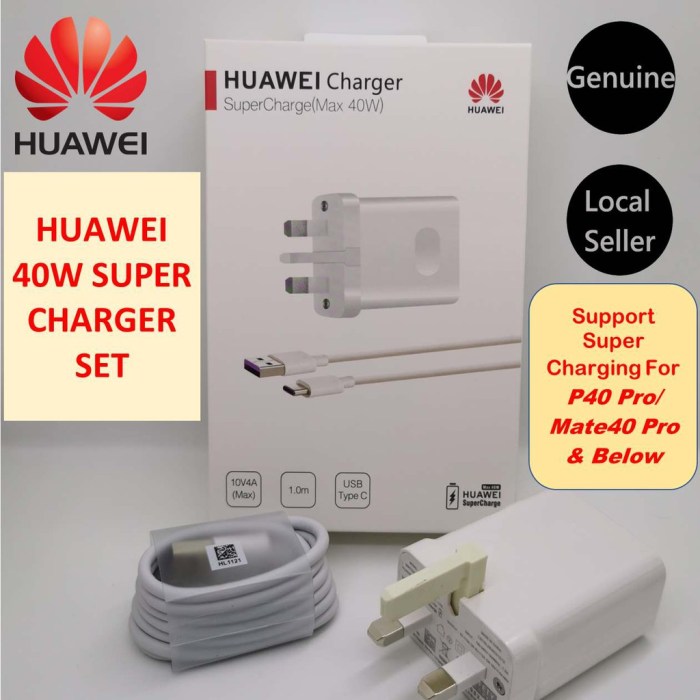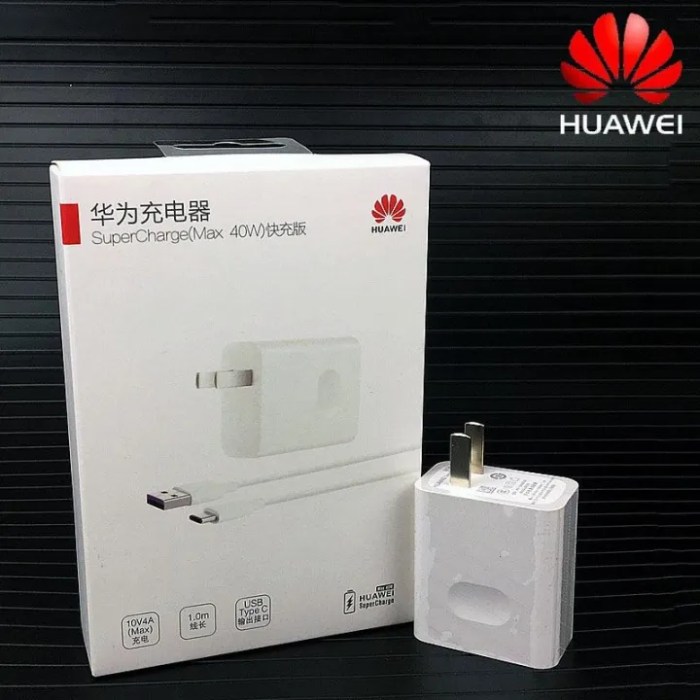Huawei P30 Pro 40W fast charging: Remember that satisfying whoosh as your almost-dead phone jolted back to life? We’re diving deep into the tech behind Huawei’s impressive 40W charging system. From battery chemistry to real-world charging times and a comparison to its competitors, we’ll unpack everything you need to know about this once-cutting-edge tech. Get ready to power up your knowledge!
This deep dive explores the Huawei P30 Pro’s 40W fast charging, examining its technical specifications, user experience, and how it stacks up against today’s standards. We’ll also tackle concerns about battery health and safety, providing practical tips to maximize your phone’s lifespan. Think of it as a complete charging guide, tailored for the tech-savvy.
Comparison to Current Charging Standards
The Huawei P30 Pro’s 40W fast charging, while impressive for its time, now sits firmly in the rearview mirror of mobile charging technology. To understand its place, we need to look at the significant leaps forward made since its 2019 release. The pace of innovation in this sector has been nothing short of breathtaking.
The advancements in charging technology since the P30 Pro’s launch have been dramatic, driven by the ever-increasing power demands of smartphones and the user’s desire for quicker charging times. This evolution isn’t just about higher wattage; it encompasses new charging protocols, wireless charging advancements, and a greater focus on battery health.
Evolution of Mobile Device Charging Technology
The evolution of mobile charging technology can be visualized as a rapid progression, marked by significant milestones.
- 2019: Huawei P30 Pro launches with 40W wired fast charging, representing a notable step forward at the time.
- 2020-2021: The industry sees a surge in 65W and 100W+ wired fast charging becoming increasingly common, with manufacturers like Xiaomi and OnePlus leading the charge (pun intended!). Wireless charging also sees improvements, moving beyond 15W to 50W and even higher in some flagship devices.
- 2022-Present: We’re now seeing the emergence of ultra-fast charging technologies exceeding 120W, with some manufacturers even exploring 200W+. Simultaneously, there’s a greater emphasis on efficient charging algorithms that minimize heat generation and prolong battery lifespan. Wireless charging continues its upward trajectory, with advancements in coil design and power delivery pushing boundaries.
Key Differences in Charging Technologies
The landscape of mobile charging is diverse, with various technologies vying for dominance. A key distinction lies between wired and wireless charging, and the use of proprietary versus standardized protocols.
| Feature | Wired Charging | Wireless Charging |
|---|---|---|
| Speed | Generally faster, capable of higher wattage | Slower than wired, wattage limited by efficiency and heat |
| Convenience | Requires a cable, less convenient | No cables needed, more convenient |
| Protocols | Proprietary (e.g., Huawei SuperCharge, OnePlus Warp Charge) and standard (USB Power Delivery) | Mostly proprietary (e.g., Qi, but with varying implementations), standardization efforts ongoing |
| Efficiency | Generally more efficient than wireless | Less efficient due to energy loss during wireless transmission |
Safety and Battery Health: Huawei P30 Pro 40w Fast Charging
Harnessing the speed of 40W fast charging on your Huawei P30 Pro requires understanding its impact on your phone’s battery. While convenient, rapid charging puts stress on the battery’s delicate chemistry. Let’s delve into the safety features and long-term implications.
The Huawei P30 Pro’s 40W fast charging incorporates several safety mechanisms to mitigate risks. These include sophisticated temperature monitoring systems that automatically throttle charging speed if the battery or phone gets too hot. This prevents overheating, a major cause of battery degradation and potential fire hazards. Furthermore, the charging circuitry includes multiple protection layers against overcharging, short circuits, and voltage fluctuations, ensuring a safe charging experience. The system also monitors the battery’s health and adjusts charging parameters accordingly, extending its lifespan.
Battery Health and Lifespan
While 40W fast charging offers convenience, it does accelerate the aging process of the battery compared to slower charging methods. This is because faster charging generates more heat, which is a known enemy of lithium-ion batteries. The increased heat accelerates chemical reactions within the battery, leading to a gradual reduction in capacity and performance over time. Slower charging methods, like 5W or 10W, generate less heat and therefore put less stress on the battery, resulting in slower degradation. However, the difference isn’t always dramatic; the convenience of fast charging often outweighs the slight reduction in overall lifespan for many users. For example, a phone using 40W charging might experience a 10% capacity reduction after a year, whereas a phone using 10W charging might see only a 5% reduction in the same timeframe. These are estimates and vary based on usage patterns and environmental factors.
Best Practices for Maximizing Battery Life with 40W Fast Charging
To prolong your battery’s life while enjoying the benefits of 40W fast charging, follow these simple steps:
- Avoid charging to 100%: Regularly charging to 100% stresses the battery. Aim for 80-90% for daily use. This reduces the prolonged exposure to high voltage levels.
- Don’t let your battery drain completely: Avoid letting your battery reach 0%. Keep it above 20% to minimize stress on the battery cells.
- Use the original charger and cable: Using third-party chargers and cables may not provide the same level of safety and charging optimization, potentially leading to damage.
- Keep your phone cool: Avoid charging your phone in direct sunlight or in hot environments. Heat is the biggest enemy of battery health.
- Optimize background apps: Close unnecessary apps running in the background to reduce battery drain.
- Update your software: Software updates often include improvements to battery management and charging optimization.
- Consider using slower charging occasionally: While not always practical, occasionally using slower charging methods can give your battery a “break” from the stress of fast charging.
Illustrative Example
Let’s imagine a typical day where your Huawei P30 Pro needs a full charge. We’ll walk through the charging process using its 40W SuperCharge technology, highlighting the speed and thermal behavior.
This example assumes a completely depleted battery. Real-world scenarios may vary slightly based on usage patterns and ambient temperature.
Charging Stages and Time
The 40W fast charging on the Huawei P30 Pro isn’t a linear process. The initial phase sees the most rapid increase in battery percentage, slowing down as the battery nears full capacity. This is a common characteristic of fast charging technologies designed to protect battery health. Here’s a breakdown:
First, you plug in the phone. The charging indicator, a vibrant green bar on the lock screen, starts to fill rapidly. In the first 30 minutes, you’ll likely see the battery jump to around 70-80%, a significant boost. The next 30 minutes will see a more gradual increase, reaching perhaps 90-95%. The final 5-10% takes noticeably longer, a safety measure to prevent overcharging and maximize battery longevity. Expect a full charge to be completed within approximately 60-75 minutes.
Heat Generation and Dissipation, Huawei p30 pro 40w fast charging
As with any fast charging technology, heat generation is unavoidable. You’ll feel a noticeable warmth emanating from the phone during the initial stages of charging, particularly in the first 30 minutes. However, the Huawei P30 Pro incorporates sophisticated thermal management. This includes intelligent algorithms that dynamically adjust the charging rate to mitigate excessive heat build-up, and a heat-dissipating design within the phone’s chassis. The phone’s temperature will gradually decrease as the charging rate slows down in the later stages. The heat generated generally remains within a comfortable range, not excessively hot to the touch.
Visual Representation of the Charging Process
Imagine the phone’s lock screen. A green battery icon displays, filling up progressively. At the beginning, the green bar jumps noticeably with each passing minute. The speed of the filling slows down gradually as it approaches full charge (100%). A small percentage number within the battery icon provides a precise indication of the current charge level. Once the charge reaches 100%, the green bar is fully filled, and a small checkmark or similar symbol may appear, indicating the completion of the charging process. The charging indicator remains on the lock screen until the phone is unplugged.
Ultimately, the Huawei P30 Pro’s 40W fast charging represented a significant leap forward in its time, offering a noticeably faster charging experience compared to many competitors. While newer technologies have since emerged, understanding its strengths and limitations provides valuable insight into the evolution of mobile charging. So, next time you’re scrambling for a quick top-up, remember the legacy of the P30 Pro’s impressive speed.
 Tech Nest Online Berita Teknologi Terbaru
Tech Nest Online Berita Teknologi Terbaru

